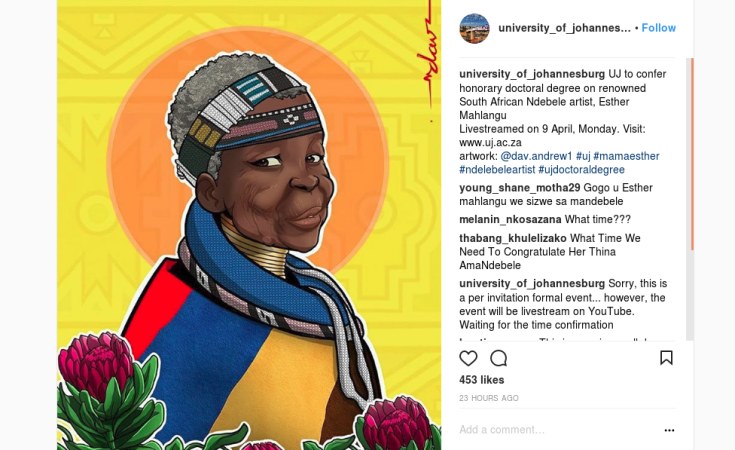At the age of 82, internationally acclaimed Ndebele artist Esther Nikwambi Mahlangu will receive an honorary doctorate from the University of Johannesburg for "her legacy as a cultural entrepreneur, skillfully negotiating local and global worlds, and as an educator," said the executive dean of the UJ Faculty of Art, Design and Architecture, Prof Federico Freschi
Esther Mahlangu is a South African artist from the Ndebele nation. She is known for her bold, large-scale contemporary paintings that reference her Ndebele heritage. She began painting as a child, at the age of 10, when she learned the art of Ndebele homestead mural painting and beadwork from her mother and grandmother, as tradition dictates.
Mahlangu's work has been said to transcend disciplines, from pop art to graphic design. She imagines her compositions without the help of preliminary drawings, and, with superhuman precision and only using a delicate chicken feather as her brush, she creates patterns using paint that echo Ndebele beadwork, then adds swathes of rich colour.
Of her start in painting, she told Artsy magazine in a 2016 interview, "I always watched my mother and grandmother when they were decorating the house. The original patterns that were painted on the houses in the past were part of a ritual of Ndebele people to announce events like a birth, death, wedding, or when a boy goes off to the initiation school. I started painting on canvas and board as I realised not everybody will be able to see the Ndebele painting in Mpumalanga, where I live, and I felt I needed to take it to them to see. This is how my work started to be exhibited in museums and galleries around the world."
Her work came to international attention in 1989 after her inclusion in the acclaimed Magiciens de la Terre exhibition held at the Centre Pompidou in Paris. In this breakout exhibition, Mahlangu used acrylic paint, contrary to the traditional neutral pigments of the Ndebele craft. This step to blend tradition with modernity elevated the art and helped create the now widely recognised Ndebele contribution to contemporary art.
"In the old days, the decoration on the houses was always done with natural pigment and cow dung, as that was the only material available," she remembers. "We were very limited with colours and used monochromatic yellow, white, ochre, black and red clay. Then acrylic paint in lots of colours was introduced, which was more durable in the rainy season. It was adopted by the younger generation of painters like myself."
Over the past 30 years, Mahlangu has exhibited mural and canvas paintings throughout Europe, Asia, North and South America, while capturing the imagination of more than one generation on social media through charitable campaigns. One such campaign was a collaboration she had last year with singer John Legend in a Belvedere Vodka advertising campaign, along with RED (a Bono-founded charitable organisation) to raise awareness and raise funds for the fight against HIV/AIDS in Africa.
This year she is set to participate in an international women's exhibition with conceptual artist Yoko Ono (now 85) at the Nirox Foundation Sculpture Park (in partnership with the Swedish Wanas Foundation) located in the Cradle of Humankind, near Johannesburg.
In a different vein, yet part of her artistic trailblazing, Mahlangu was the first commission in BMW's collaboration with women. Thomas Girst, an art historian, author, and Head of Cultural Engagement at BMW, commissioned the artist to paint the interior panels of a BMW Individual 7 Series. This came 25 years after they asked her to paint their 1991 BMW Art Car.
Her first car followed in a lineage that includes Andy Warhol, Alexander Calder, Frank Stella, Roy Lichtenstein, Robert Rauschenberg, and many well-known male artists. "We opened our plant in Rosslyn, South Africa, in 1986 and have had a big presence there ever since," Girst told Artsy of the decision to work with Mahlangu. "And Nelson Mandela was freed from prison [in 1990]. So 1991 was the year that the commitment was made to do something for the art scene there. That was embodied in the commission of Esther Mahlangu. I'm proud of that heritage, and of her becoming the first woman artist to tackle the project."
The University of Johannesburg said as a national icon and custodian of heritage, Mahlangu has been honoured with awards and medals by government many times and by more than one South African president, making her a stellar candidate for this latest honour.
"In the context of current debates in South African institutions of higher learning on questions of the decolonisation of the curriculum," says Prof Freschi, "Esther Mahlangu is a living example of how authentic African knowledge systems can be articulated meaningfully and sustainably. In her, we have an icon worthy of being looked up to by the next generation of creatives, and the university, in particular the Faculty of Art, Design and Architecture, is greatly honored to confer the degree of Philosophiae Doctor Honoris Causa on her."
During a News24 interview at her homestead in Mpumalanga, Mahlangu said: "Through my art, I have seen the world. People from all over the world come to KwaNdebele to learn about my culture.
"IsiNdebele is my culture and I love it. I speak isiNdebele, I walk isiNdebele and I wear isiNdebele," she said proudly - in isiNdebele.


